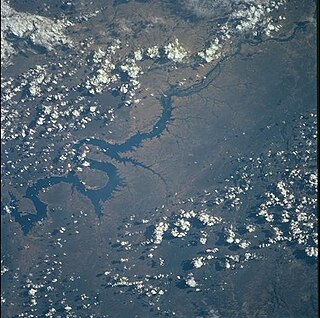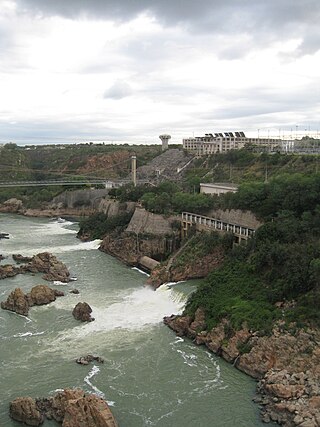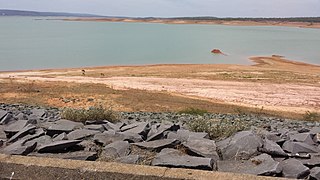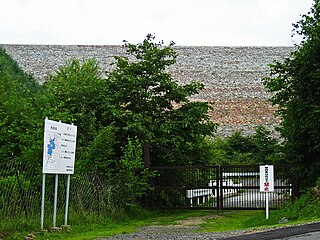
The Itaipu Dam is a hydroelectric dam on the Paraná River located on the border between Brazil and Paraguay. It is the third largest hydroelectric dam in the world, and holds the 45th largest reservoir in the world.

The Dnieper Hydroelectric Station, also known as the Dnipro Dam, is a hydroelectric power station in the city of Zaporizhzhia, Ukraine. Operated by Ukrhydroenergo, it is the fifth and largest station in the Dnieper reservoir cascade, a series of hydroelectric stations on the Dnieper river that supply power to the Donets–Kryvyi Rih industrial region. Its dam has a length of 800 metres (2,600 ft), a height of 61 metres (200 ft), and a flow rate of 38.7 metres (127 ft) per second.

The Mingachevir Dam is an earth-fill embankment dam on the Kura River just north of Mingachevir in Azerbaijan. It serves several purposes, including hydroelectric power production and water storage for irrigation. The Mingachevir reservoir, behind the dam, supplies water to the Upper Qarabag and Upper Sirvan channels which help irrigate about 1,000,000 ha of farmland in the country. Its six Francis turbine-generators were overhauled or replaced with 70 megawatts (94,000 hp) sets in 2000. Mingachevir reservoir has a storage capacity of 15.730 cubic kilometres (12,753,000 acre⋅ft), covering 605 km2 (234 sq mi). The length of the dam is 1,550 metres (5,090 ft), its width is 16 metres (52 ft) and height is 80 m (260 ft). It is the largest hydroelectric power station in the South Caucasus, and is located on Kura river, not far from Mingachevir city.
Guavio River is a river of central Colombia. It is a right tributary of the Upía River, in the drainage area of the Orinoco.

The Xingó Dam is a concrete face rock-fill dam on the São Francisco River on the border of Alagoas and Sergipe, near Piranhas, Brazil. The dam was built for navigation, water supply and hydroelectric power generation as it supports a 3,162 megawatts (4,240,000 hp) power station. It was constructed between 1987 and 1994 and the last of its generators was commissioned in 1997. In Portuguese, the dam is called the Usina Hidrelétrica de Xingó.

The Luiz Gonzaga Dam, formerly known as the Itaparica Dam, is a rock-fill embankment dam on the São Francisco River 25 kilometres (16 mi) downstream of Petrolândia in Pernambuco, Brazil. The dam was built for navigation, and hydroelectric power generation as it supports a 1,479 megawatts (1,983,000 hp) power station. It was constructed between 1979 and 1988; the last of its generators was commissioned in 1990.

The Paulo Afonso Hydroelectric Complex, also known as the Paulo Afonso Complex, is a system of three dams and five hydroelectric power plants on the São Francisco River near the city of Paulo Afonso in Bahia, Brazil. The complex exploits an 80-metre (260 ft) natural gap on the river, known as the Paulo Afonso Falls. Constructed in succession between 1948 and 1979, the dams support the Paulo Afonso I, II, III, IV and Apollonius Sales (Moxotó) power plants which contain a total of 23 generators with an installed capacity of 4,279.6 megawatts (5,739,000 hp).
The Salto Osório Hydroelectric Power Plant is a dam and hydroelectric power plant on the Iguazu River near Osório in Paraná, Brazil. It is the second dam upstream of the Iguazu Falls and was completed in 1979. The power station has a 1,078 MW capacity and is supplied with water by a rock-fill embankment dam.

The Governor Ney Braga de Barros Hydroelectric Plant, formerly known as Segredo, is a dam and hydroelectric power plant on the Iguazu River near Segredo in Paraná, Brazil. It is the fourth dam upstream of the Iguazu Falls and was constructed between 1987 and 1991 while being inaugurated in 1992. The power station has a 1,260 megawatts (1,690,000 hp) capacity and is supplied with water by a concrete face rock-fill embankment dam.
The Governor Bento Munhoz da Rocha Netto Hydroelectric Plant, formerly known as Foz do Areia, is dam and hydroelectric power plant on the Iguazu River near Foz do Areia in Paraná, Brazil. It is the furthest dam upstream of the Iguazu Falls and was constructed between 1976 and 1980. The power station has a 1,676 megawatts (2,248,000 hp) capacity and is supplied with water by a concrete face rock-fill embankment dam.

The Engineer Sérgio Motta Dam, formerly known as the Porto Primavera Dam, is an embankment dam on the Paraná River near Rosana in São Paulo, Brazil. It was constructed between 1980 and 1999 for hydroelectric power production, flood control and navigation. An estimated 11 million tropical trees were submerged.

The Três Marias Dam, also known as Bernardo Mascarenhas, is an embankment dam on the São Francisco River near Três Marias in Minas Gerais, Brazil. It was constructed for hydroelectric power production and flood control. The dam was completed in 1961 and its first generator was operational in 1962. The dam's power plant is named after Bernard Mascarenhas who in 1889, built South America's first major hydroelectric power plant in Brazil, the Marmelos Zero Power Plant.

La Esmeralda Dam is an embankment dam on the Batá River northwest of Santa María in Boyacá Department, Neira Province, Valle de Tenza Colombia, 52 km to south of Tunja city. The primary purpose of the dam is hydroelectric power production and it is part of the Chivor Hydroelectric Project. Water from the Batá is diverted by the dam to a power station that discharges to the Lengupá River. The power station supplies 8% of Colombia's power demand.

The Miel I Dam, officially known as the Patángoras Dam, is a gravity dam on La Miel River just south of Norcasia in Caldas Department, Colombia. The dam was constructed between 1997 and 2002 for the primary purpose of hydroelectric power generation. At the time of its completion, the dam was the tallest roller-compacted concrete (RCC) dam in the world but was surpassed by the Longtan Dam in 2009.
The Punchiná Dam is an embankment dam on the Guatapé River 17 kilometres (11 mi) east of San Carlos in Antioquia Department, Colombia. The dam creates Punchiná Reservoir which is part of the 1,240 megawatts (1,660,000 hp) San Carlos Hydroelectric Power Plant. The power plant was completed in two 620 megawatts (830,000 hp) stages, the first was completed in 1984 and the second in 1987. It is the largest power station in Colombia.
The Porce III Dam is an embankment dam on the Porce River 90 kilometres (56 mi) northeast of Medellín in Antioquia Department, Colombia. The dam was constructed between 2004 and 2011 for the primary purpose of hydroelectric power generation.

The Kazunogawa Pumped Storage Power Station is a pumped-storage hydroelectric power station near Kōshū in Yamanashi Prefecture, Japan. The station is designed to have an installed capacity of 1,600 megawatts (2,100,000 hp) and three of the four 400 megawatts (540,000 hp) generators are currently operational, for a total operational capacity of 1200 MW. Construction on the power station began in 1993 and the first generator was commissioned on 3 December 1999. The second was commissioned on 8 June 2000. The third one became operational on 9 June 2014, six year early due to post-power demand from the Great East Japan earthquake. The fourth and final generator is slated to be commissioned by 2024. It is owned by TEPCO and was constructed at a cost of US$2.2 billion.

The Sogamoso Dam is a concrete-face rock-fill dam on the Sogamoso River in northern Colombia. It is located 30 kilometres (19 mi) west of Bucaramanga in Santander Department and 285 kilometres (177 mi) north of Bogotá. The primary purpose of the dam is hydroelectric power generation and its power plant has an installed capacity of 820 megawatts (1,100,000 hp) which increased Colombia's generating capacity by 10 percent. Construction on the dam began in February 2009 and its first 273 MW Francis turbine-generator was commissioned on 1 December 2014. The other two generators were operational by 20 December 2014. The US$1.74 billion dam and power plant is owned by ISAGEN. INGETEC designed the dam in the 1990s and Impreglio was awarded the contract for construction.

Bemposta Dam is a concrete arch dam on the Douro, where the river forms the national border line between Spain and Portugal. It is located in the municipality Mogadouro, in Bragança District, Portugal.















